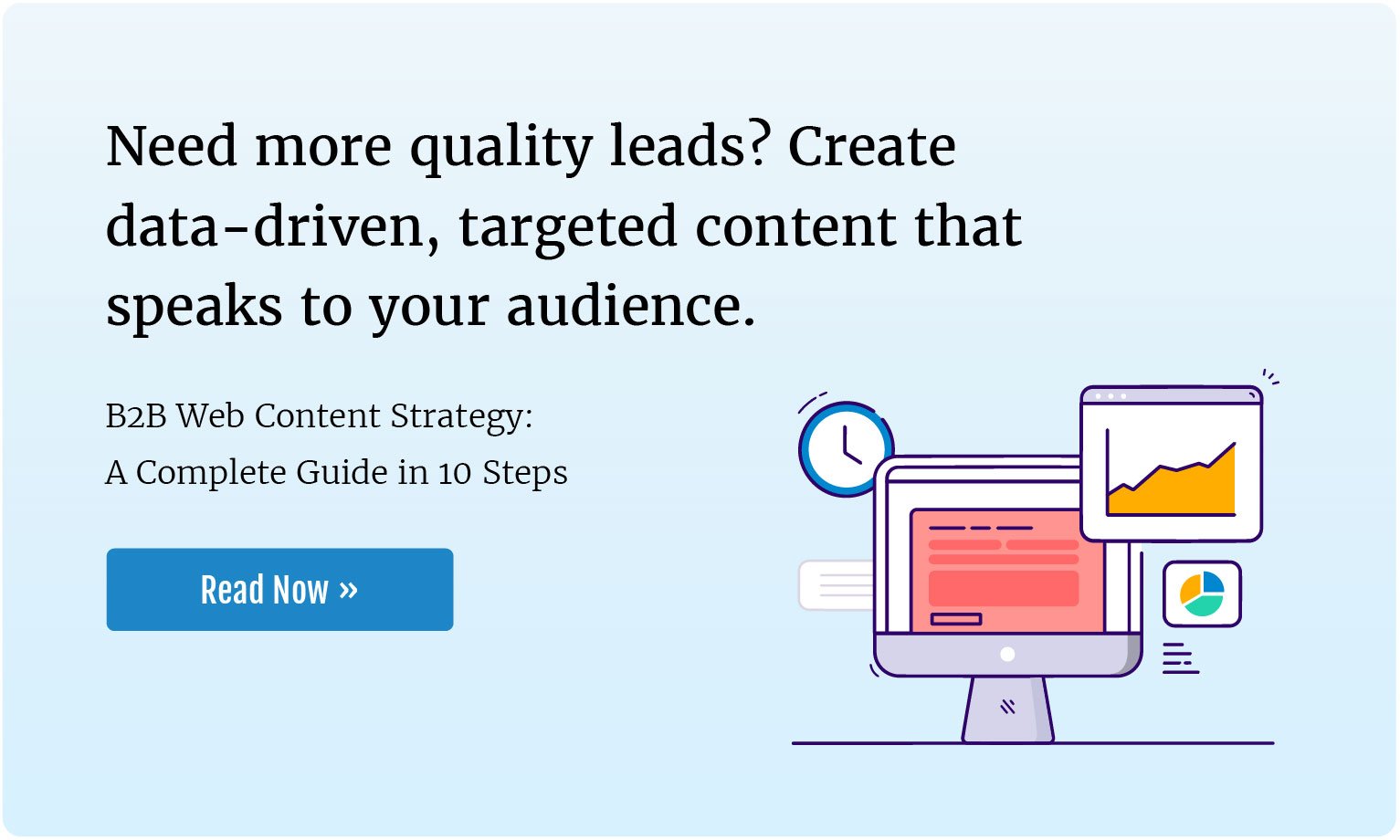Maybe your colleagues have talked about them. Maybe you’ve been tasked with writing one. Or maybe you’ve come across articles discussing their virtues and where they fit into your marketing mix.
But pinning down a satisfying definition of exactly what a pillar page is—in a way that's genuinely helpful for creating one—can be tough to find. There's tons on perspectives floating around the web.
So at the risk of adding more noise to an already loud conversation, we've kept it short and simple.
Read on for a functional definition of a pillar page how the concept has expanded to include several varieties of pillar pages.
Table of Contents
- What is a pillar page?
- Pillar page types
- Pillar pages for SEO
- Pillar pages vs. other web pages
- How to create a pillar page
- Conclusion and next steps
What is a pillar page (aka content pillar)?
Pillar pages are in-depth guides that comprehensively explore a topic, answer questions related to that topic, and link out to related, in-depth content.
Pillar pages are ungated—that is, not locked away behind a form—and freely available to searchers.
Pillar pages form the cores of "topic clusters", which are used to organize content on websites. Let's unpack that a bit.
What are topic clusters?
Topic clusters are groups of related content connected by links. They're made up of a pillar page about a core topic, related subtopic content, and the links to and from the pillar to the subtopic content.
They're an SEO and user-friendly system of organizing content by topical relevance.
.jpg?width=600&name=5f3597df1297c5c4314d5c24_jrPM95P0mQ7kkoDfgC2wRakOZyyMTLA65QPqqm2-CAgMLbM7KiXBeH43ys3pGScMFnA0lgJoqzWhKxUGKONt-qC-b_dgTqf05M1smKlw81S9ZhLX3_ujE6cw2saghOdruymRcdSR%20(2).jpg)
Source: HubSpot
For example, a pillar page about Madison area planned communities might link out to blog posts that feature each community. These posts, in turn, would link back to the pillar page.
HubSpot's video below does a great job explaining and visualizing the idea further.
One thing to keep in mind is that topic clusters are not always this tidy. A topic cluster might center around two, directly related pillar pages.
Other times, a pillar page might be a satellite of another pillar page. These pages take many different shapes and sizes—all riffing on this basic concept.
Pillar page types
When you mention pillar pages, most people think of the 10x content pillar page, but there are actually two main types, each with their own variations: 10x content pillar pages and resource pillar pages.
While these types differ considerably, they have a few structural similarities. Most pillar pages contain:
- An H1 headline containing target keywords
- An introduction that provides a definition of, and background for, the general topic.
- Subsections that deal with the most important subtopics
- Internal links
10x content pillar pages
10x content pillar pages are the most popular and easily recognizable type of pillar page. They contain your own proprietary content, and often take the shape of an in-depth report or guide.
These pillars provide background information for their target topic, and then provide details about subtopics, with links to other resources where readers can learn more.
They can be about any subject, from SEO to healthcare, and range from white-paper or e-book-like guides to interactive visual feasts. They may include any media type, from infographics to embedded videos.
The "10X" part simply means "10 times better than anything I can find in the search results today" according to Moz, who coined the term "10x content" in 2015.
It comes from a strategy where you examine competitor content appearing for the searches you want to appear for and make better content to outranks them.
Reports and journalistic articles
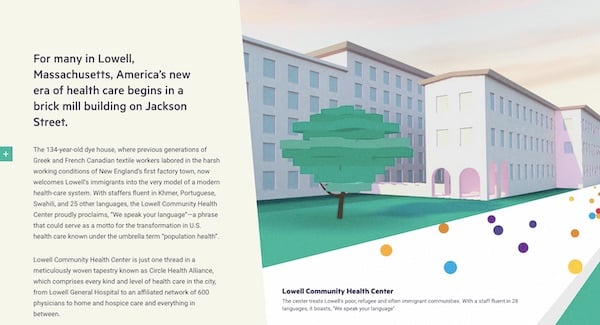 A report in pillar page form; example from Amanda Zantal-Wiener; Source: the Atlantic
A report in pillar page form; example from Amanda Zantal-Wiener; Source: the Atlantic
Inspirational pages about best practices or tips

Source: NYT
"what is" content pillars
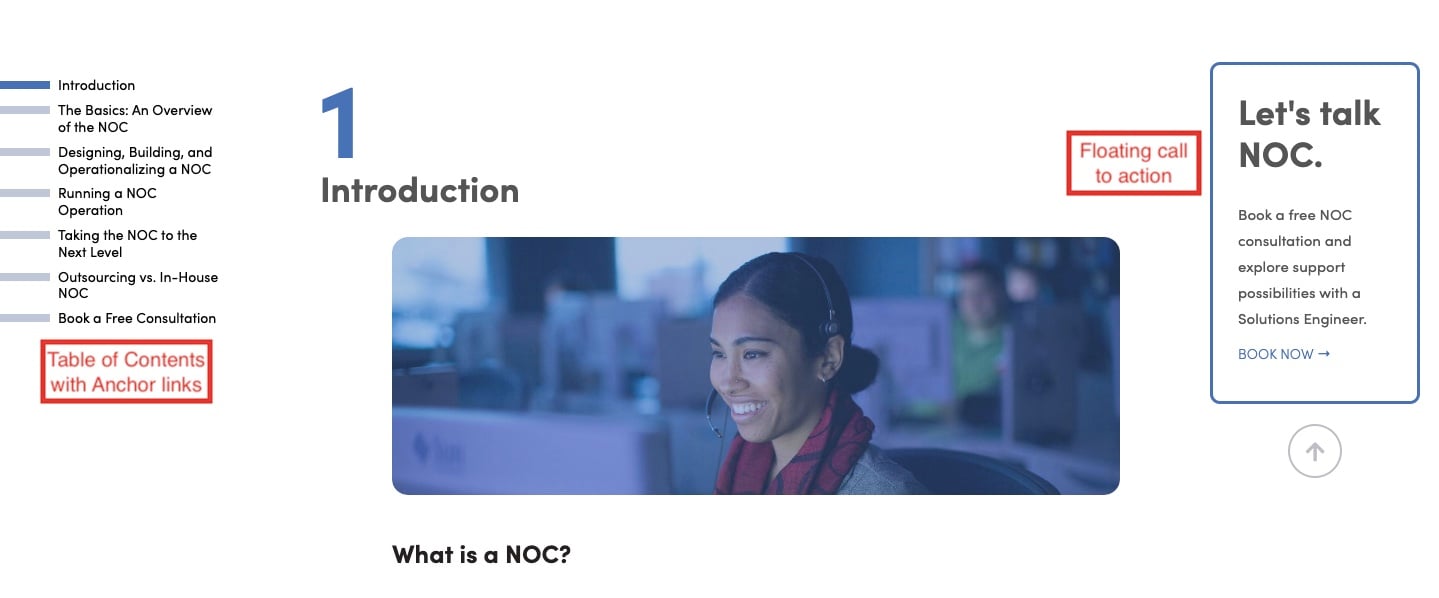 What is a NOC? pillar; Source: INOC
What is a NOC? pillar; Source: INOC
"How to" pillar pages
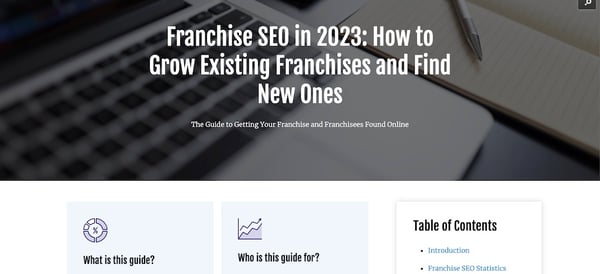
A “how to” pillar page
"Guide to" pillar pages
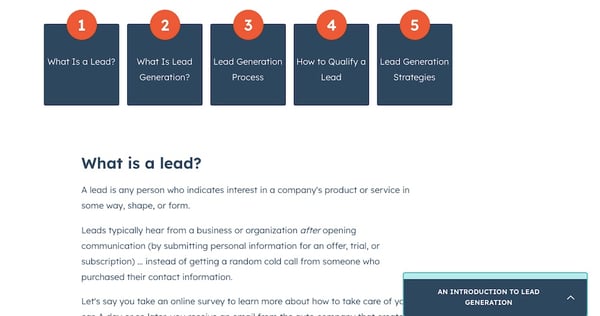
guide pillar page; Source: HubSpot
Resource pillar pages
Resource pillar pages are curated collections of links to helpful resources for a topic and its subtopics, with commentary.
Like 10x pages, they focus on a broad topic and briefly cover all the major subtopics around it with links to more focused resources for each subtopic.
However, unlike 10x pillar pages, instead of in-depth explanations, they provide blurbs with lists of links to other resources. In some cases, each resource will have a thumbnail preview and/or its own blurb.
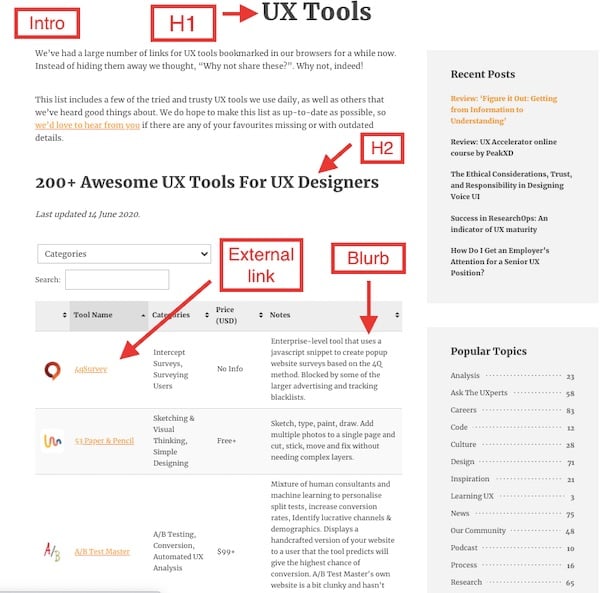 Resource pillar page; Source: UX Mastery
Resource pillar page; Source: UX Mastery
Resource pillar pages can be internally-focused and/or externally focused. For example, the link-building pillar page above focuses exclusively on internal links.
Other pages may curate a collection of external links to resources on other websites plus some internal links to its own content.
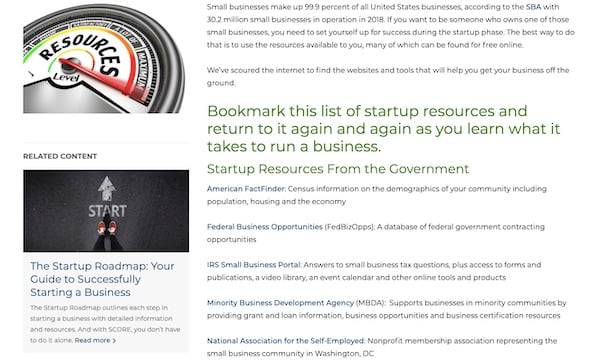 An externally-focused resource pillar; Source: Score.org
An externally-focused resource pillar; Source: Score.org
This may be a good option if you want to write about a topic that has already been covered thoroughly by other websites. The downside is that you must update the links regularly to make sure everything is up-to-date.
If the goal of a 10x pillar page is to attract traffic and maybe get a few potential customers to download a PDF version, the goal of resource pillar pages is to get bookmarked.
Resource pillar pages are reference tools. Like a good librarian, they save readers the time and energy of hunting down helpful content for research. They can also score backlinks from writers who want to point readers toward learning resources.
Pillar pages for SEO
Pillar pages are great for search engine optimization for five main reasons.
1. They make your content easier to crawl
Google uses algorithms (or crawlers) to scan your page to learn what your content is about. If Google knows what topics and subtopics your content covers, it is more likely to recommend it to searchers.
This is especially true in the age of "semantic search," where Google's algorithm is able to make sophisticated connections between words and topics across the web.
A well-organized pillar page makes it easy for Google and other search engines to crawl.
While crawling, search engines will follow links in your pillar page to related pages, which will give it an even better idea of how your content relates to other pieces of content (about your topic) on your site and other sites.
2. They satisfy search intent
Search intent interrogates what someone is trying to "do" when conducting a particular search, whether it's finding answers, buying something, or something else entirely.
Most "content" satisfies a searcher's intent to learn, so a comprehensive pillar page should serve that function as the best place to get answers and cover a topic from every angle.
Google’s algorithm tends to reward content that is helpful to readers by ranking it higher on search result pages and/or by letting it appear more often. As a result, satisfying search intent pleases both searchers and algorithms.
3. They enhance user experience
User experience (UX) refers to the ease with which a person can interact with a site or use a product. Great UX means a minimum of hassle or "friction" for users.
Google uses many factors to judge websites and web pages. Most of them boil down to providing a great user experience or satisfying search intent. Great pillar pages help you do both.
On a macro level, organizing content with topic clusters makes it easier for readers to find what they need on your site.
On a micro level, a well-formatted pillar page is broken up into sections and subsections, which makes it easy to skim. Pillar pages also provide a table of contents which allows readers to skip to the section they most want to read.
Great organization makes for a better user experience.
4. They’re full of internal links and invite backlinks
If your pillar page becomes a great resource for potential customers and other professionals in your industry, you might be able to earn backlinks.
Backlinks are links from other web pages to yours. They show Google and visitors that other websites trust you. If reputable sites trust you, Google assumes that your site must be reputable, too, and this can help your pages rank higher in search results.
Pillar pages connect your content together using internal links. Links are a pipeline for “link juice,” another name for that digital social credit that your pillar page scores by getting backlinks and doing well in search results.
This link juice travels from your high ranking page to every internal page connected with it, helping raise the reputation of the entire topic cluster.
5. They help structure your content strategy
In order to create topic clusters, you must audit your existing content and identify the topics most important to your business.
By auditing your content, you can identify what important topics you haven’t written as much about. This can help you organize existing content and plan future content that will interest your ideal customer.
Pillar pages vs. other web pages
Resource pillars vs. resource pages
Resource pillar pages are not the same as regular resource pages.
Resource pages typically do not contain content like definitions, introductions, or blurbs. Usually, they group content by topics and subtopic, rather than the needs of the visitor.
Resource pillar pages, on the other hand, group resources by which problem they help a visitor solve.
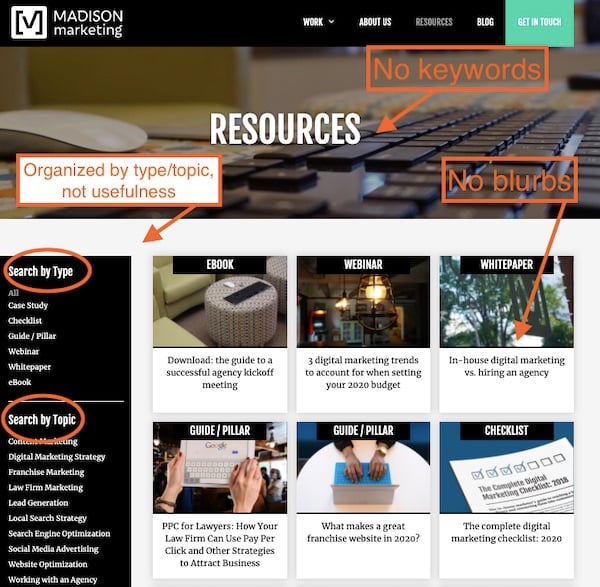 Our resource page; Source: Madison Marketing Group
Our resource page; Source: Madison Marketing Group
Resource pillar pages: designed to educate the reader about a topic and gather internal and external resources for them to use.
Resource pages: designed to help the reader find an internal resource.
Pillar pages vs. landing pages
How landing pages work
A content pillar may be the first page a visitor lands on, but they don't serve as traditional landing pages aimed at conversion. The goal of a landing page is to convert a visitor into a contact and generate a lead.
Toward that end, its features and UX differs from a pillar page. Copy is concise. Site navigation is limited or has been removed so visitors must focus on taking a next action rather than browsing your site. The list goes on.
Some pages have more information about the business and/or their products and services to inform the visitor’s decision whether to convert or not. However, they are not designed as educational content.
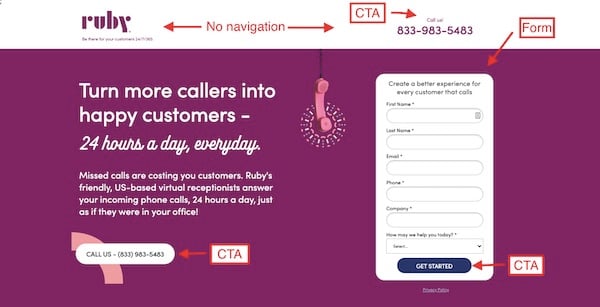 Landing page; Source: Ruby
Landing page; Source: Ruby
Visitors typically arrive on landing pages after clicking on a call to action or ad. Once they get to the landing page, they are prompted to provide personal information to get something.
If they choose to do that, they arrive on a thank you page where they are able to download the content or receive the offered item. That’s a lot of steps. Some visitors will leave before making it to the thank you page.
How pillar pages work
Pillar pages are the opposite of landing pages in many ways. Their primary goal is not to convert visitors into potential customers, but to attract potential customers to your site.
Great pillar pages often rank well on search engine result pages, attracting traffic to your site.
After attracting searchers’ attention, pillar pages delight visitors with free, educational content which also contains CTAs that give them opportunities to convert.
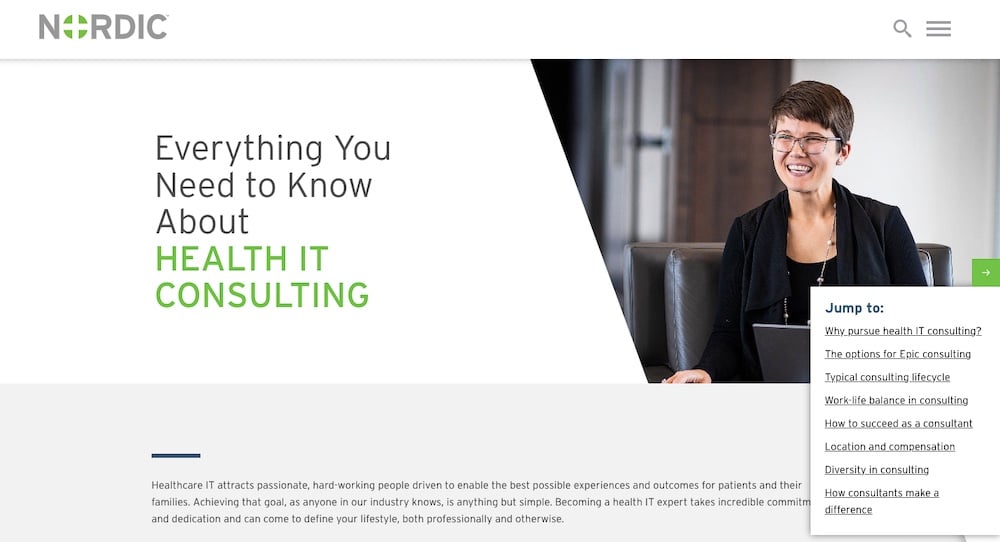
Pillar page; Source: Nordic
Finally, many pillar pages offer a PDF version which can be downloaded (for the price of contact information) if visitors want to have it for keeps.
In this way, pillar pages attract qualified traffic with content that nudges them closer to a purchase and build a website’s reputation by satisfying searchers.
Pillar pages vs. blog posts
The line between pillar pages and blog posts is not hard and fast. There are different variations on the concept of the pillar page. There are many types of blog posts as well, including the long-form blog post, which some consider a type of pillar page.
A long-form blog post may be laid out similarly to a 10x pillar page. It covers a topic in-depth and addresses many subtopics.
But rather than addressing a broad core topic, it often goes into depth about a specific topic that may not directly relate to one of your core topics. It may also link to outside sources to explain a concept in more depth.
The fundamental difference between blog posts and pillar pages is functional.
Pillar pages are designed to organize many related pieces of content on your site, unlike blog posts.
Blog posts may link to other content on your site, but they do not form the center of a topic cluster. Blog posts tend to be satellites of a pillar page within a topic cluster, linking back to that pillar page.
That said, sometimes websites house pillar pages on their blog, in which case the content is both a pillar and a blog post.
What is a hub page (vs. a pillar page)?
They are the same thing. Hub pages address a broad topic and connect to subtopic pages via links.
How to create a pillar page
Here's how to create pillar page in a nutshell:
- Identify a broad topic that interests your audience
- Identify a term your audience is using to search for information on this topic
- Search for that term and see what ranks at the top of the page
- Choose a pillar page type based on what you learn from competitor research and your goals (e.g. what is, resource pillar)
- Provide an overview of that topic that covers all the main subtopics your competitors cover (and more)
- Link from each subtopic section to related content on your site. If you don't have related content, create it. If you're writing a resource pillar, do this for internal resources, and just link out to external ones.
- Link from that related content back to your pillar page.
- Edit, publish, and promote your new pillar page.
Learn more about building pillar pages →
Conclusion and Next Steps
While these are the most common pillar page types you'll see, pillar pages are a flexible form, and content creators are free to experiment with different formats, content types, topics, and combinations.
Pillar pages are an excellent way to improve your site’s SEO, increase site traffic, gather leads, improve user experience, audit your content, and focus your content strategy on the topics that are most important to your audience—all in one fell swoop.
Topics: Search Engine Optimization, Pillar Pages



